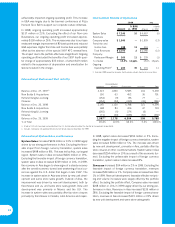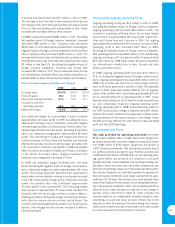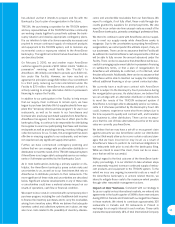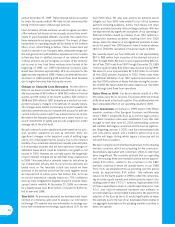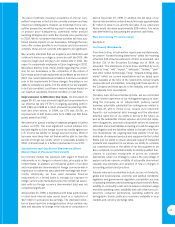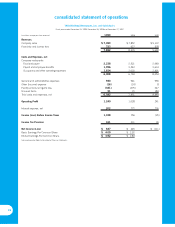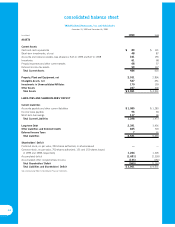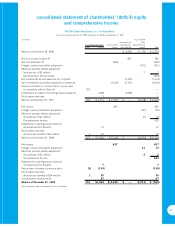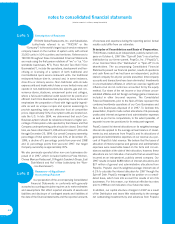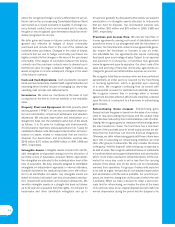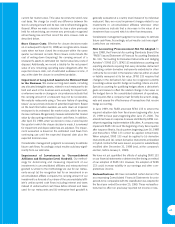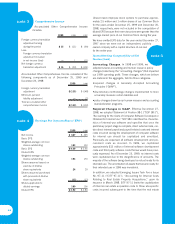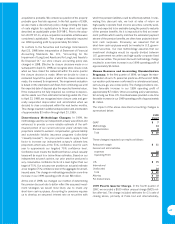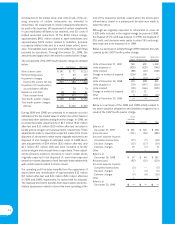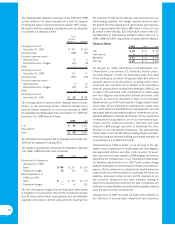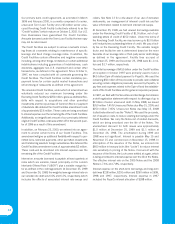Pizza Hut 1999 Annual Report Download - page 44
Download and view the complete annual report
Please find page 44 of the 1999 Pizza Hut annual report below. You can navigate through the pages in the report by either clicking on the pages listed below, or by using the keyword search tool below to find specific information within the annual report.
42
Description of Business
TRICON Global Restaurants, Inc. and Subsidiaries
(collectively referred to as “TRICON” or the
“Company”) is the world’s largest quick service restaurant
company based on the number of system units, with almost
30,000 units in 104 countries and territories. References to
TRICON throughout these Consolidated Financial Statements
are made using the first person notations of “we” or “us.” Our
worldwide businesses, KFC, Pizza Hut and Taco Bell (“Core
Business(es)”), include the operations, development and fran-
chising or licensing of a system of both traditional and
non-traditional quick service restaurant units. Our traditional
restaurants feature dine-in, carryout and, in some instances,
drive-thru or delivery service. Non-traditional units include
express units and kiosks which have a more limited menu and
operate in non-traditional locations like airports, gas and con-
venience stores, stadiums, amusement parks and colleges,
where a full-scale traditional outlet would not be practical or
efficient. Each Core Business has proprietary menu items and
emphasizes the preparation of food with high quality ingredi-
ents as well as unique recipes and special seasonings to
provide appealing, tasty and attractive food at competitive
prices. Approximately 33% of our system units are located out-
side the U.S. In late 1994, we determined that each Core
Business system should be rebalanced toward a higher per-
centage of total system units operated by franchisees and that
Company underperforming units should be closed. Since that
time, we have refranchised 5,138 units and closed 2,119 units
through December 25, 1999. Our overall Company ownership
percentage of total system units was 23% at December 25,
1999, a decline of 5 percentage points from year-end 1998
and 11 percentage points from year-end 1997. Our target
Company ownership is approximately 20%.
We also previously operated other non-core businesses dis-
posed of in 1997, which included California Pizza Kitchen,
Chevys Mexican Restaurant, D’Angelo’s Sandwich Shops, East
Side Mario’s and Hot ’n Now (collectively, the “Non-
core Businesses”).
Summary of Significant
Accounting Policies
Our preparation of the accompanying Consolidated
Financial Statements in conformity with generally
accepted accounting principles requires us to make estimates
and assumptions that affect reported amounts of assets and
liabilities and disclosure of contingent assets and liabilities at
the date of the financial statements and the reported amounts
of revenues and expenses during the reporting period. Actual
results could differ from our estimates.
Principles of Consolidation and Basis of Preparation.
TRICON was created as an independent, publicly owned com-
pany on October 6, 1997 (the “Spin-off Date”) via a tax-free
distribution by our former parent, PepsiCo, Inc. (“PepsiCo”),
of our Common Stock (the “Distribution” or “Spin-off”) to its
shareholders. The accompanying Consolidated Financial
Statements present our financial position, results of operations
and cash flows as if we had been an independent, publicly
owned company for all prior periods presented. Intercompany
accounts and transactions have been eliminated. Investments
in unconsolidated affiliates in which we exercise significant
influence but do not control are accounted for by the equity
method. Our share of the net income or loss of those uncon-
solidated affiliates and net foreign exchange gains or losses are
included in other (income) expense. The Consolidated
Financial Statements prior to the Spin-off Date represent the
combined worldwide operations of our Core Businesses and
Non-core Businesses disposed of in 1997. To facilitate this
presentation, PepsiCo made certain allocations of its previously
unallocated interest and general and administrative expenses
as well as pro forma computations, to the extent possible, of
separate income tax provisions for its restaurant segment.
PepsiCo based its interest allocations on its weighted-average
interest rate applied to the average annual balance of invest-
ments by and advances from PepsiCo and its allocations of
general and administrative expenses on our revenue as a per-
cent of PepsiCo’s total revenue. We believe that the bases of
allocation of interest expense and general and administrative
expenses were reasonable based on the facts and circum-
stances available at the date of their allocation, however, these
allocations are not indicative of amounts that we would have
incurred as an independent, publicly owned company. Our
1997 results included $188 million of interest allocations and
$37 million of general and administrative allocations from
PepsiCo. PepsiCo used its weighted-average interest rate of
6.1% to calculate the interest allocation for 1997 through the
Spin-off Date. PepsiCo managed its tax position on a consoli-
dated basis, which took into account the results of all of its
businesses. For this reason, our historical effective tax rates
prior to 1998 are not indicative of our future tax rates.
In addition, our capital structure changed in 1997 as a result
of the Distribution and bears little relationship to the average
net outstanding investments by and advances from PepsiCo
notes to consolidated financial statements
(tabular amounts in millions, except share data)
note 1
note 2


